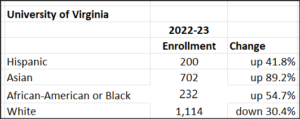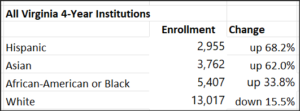by James A. Bacon
As the debate unfolds about how to apply the U.S. Supreme Court ruling restricting the use of race as a factor in college admissions, it would be helpful for the discussion to be rooted in reality. At the University of Virginia, any dialogue should be based upon the recognition that admissions policies have transformed the racial/ethnic profile of the undergraduate student body over the past 10 years.
According to enrollment data published by the State Council for Higher Education in Virginia (SCHEV), the racial/ethnic make-up of students entering UVa for the first time (as first-year students or community college transfers) has changed significantly between the fall of 2013-14 and the fall of 2022-23:

Remarkably, the percentage of undergraduate White students has declined from 59.3% of the entering class at UVa to 46.9% over a single decade. Non-Hispanic Whites are now a minority.
For purposes of comparison, non-Hispanic Whites account for 57% of Virginia’s population and 48% of all public high school students. If we adjust the comparison to include private school students, who are disproportionately White and account for 11% of Virginia school enrollment, it would appear that non-Hispanic Whites are now under-represented among entering undergraduate students at UVa.
A logical question arises: how does the transformation of the UVa student body compare to admissions trends in Virginia’s higher-education system as a whole? Do the enrollment numbers reflect statewide trends affecting all institutions, or are they the result of policies specific to UVa?
To some degree, UVa’s enrollment reflects the changing demographics of Virginia’s college-bound youth. More Asians, Blacks and Hispanics are enrolling in the state’s four-year colleges, while the White college population has declined over the past decade. Here are the numbers for all first-time enrollees at Virginia four-year institutions (both public and private):

However, broader enrollment trends do not fully account for the change in UVa enrollment numbers. UVa enrollments depart significantly from the statewide trend. While the number of entering Asians surged 68.2% statewide, they shot up 89.2% at UVa. Similarly, while Black enrollment leaped ahead 33.8% statewide, it increased 54.7% at UVa. (The increase in the percentage of Hispanics at UVa rose, but the rise lagged statewide figures.)
Here is the most notable departure from the statewide pattern: while White enrollment in Virginia four-year institutions declined 15.5% statewide, it collapsed by 30.4% at UVa.
Despite evidence that Asians are discriminated against in admissions — their percentages of UVa enrollment would be even higher if based purely upon measures of academic achievement such as standardized test scores and high school grade-point averages — their numbers have surged. The numbers of Blacks and Hispanics also have seen robust increases at UVa.
Non-Hispanic Whites have been the big losers from changes in UVa admissions policies over the past decade. Given the fact that Whites were under-represented in the latest entering class, can it also be said that UVa admissions discriminate against Whites?
That’s a trickier question that hinges in part upon how one defines “discriminate.” If admissions criteria are based entirely upon standardized test scores and grade-point averages, then, yes, UVa discriminates against Whites and Asians in favor of Blacks and Hispanics. If admissions criteria incorporate traits such as personality, character, and a demonstrated ability to overcome adversity, then not necessarily. The question then becomes how objective those criteria are and how subject they are to bias in favor of the so-called marginalized groups.
As the Ryan administration sorts out the implications of the Supreme Court ruling, it will be impossible for the UVa community to engage in an informed dialogue without a clear statement of the admissions criteria, the weights those criteria are given, and the process by which admissions decisions are made. Without greater openness, any discussion will be fraught with unknowns, ambiguity and conflicting narratives disconnected from reality.

Leave a Reply
You must be logged in to post a comment.